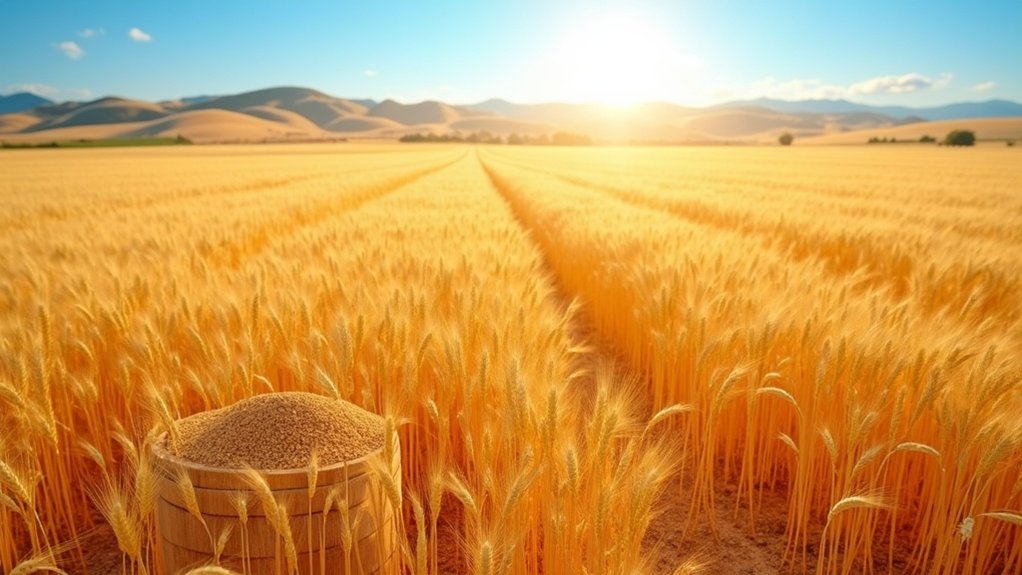Agricultural yields measure crop output per land unit, typically in tonnes per hectare. Farmers calculate them by dividing total production by harvested area. Genetics, environment, pests, and management all influence yields notably. Modern technology like AI and remote sensing have revolutionized forecasting accuracy, replacing guesswork with science. Curiously, crypto “yield farming” borrows this agricultural terminology, with similar principles of input management for maximum returns. The parallels between these worlds run deeper than most realize.
Every farmer knows the deal. You plant a seed, you get a crop. But it’s never that simple, is it? Yields in farming represent the quantity of agricultural product per land unit—typically measured in tonnes per hectare. Basic math. Total production divided by harvested area. Done.
These measurements apply to everything from wheat and maize to livestock products like milk or wool. The numbers don’t lie, but they’re not always reliable. Permanent crops like grapes and cocoa? Their yield data gets sketchy fast because of area measurement issues. Like liquidity pools in crypto farming, agricultural yields require careful monitoring and management to maximize returns.
Genetics matter enormously. Plant the wrong variety, get disappointing results. Environmental factors? Significant. Sunlight, water, nutrients—they all determine whether you’re celebrating at harvest or drowning your sorrows. Weeds and pests aren’t just annoying—they’re yield killers. Agricultural practices make or break your season. Rotate those crops. Use fertilizer wisely. Fight those pests. Or don’t, and watch your profits vanish.
Success or failure in farming isn’t chance—it’s science. Choose genetics wisely, manage your environment, or pay the price at harvest.
Modern farming isn’t guesswork anymore. Machine learning and AI have revolutionized yield forecasting. Remote sensing technologies can predict outcomes before a farmer even steps into the field. It’s not magic. It’s science.
The metrics are straightforward. Tonnes per hectare. Seed multiplication ratio—how many seeds you harvest compared to what you planted. Three-field crop rotation improved this ratio from a pathetic 1:2.5 to an impressive 1:14 in parts of Europe. Progress, slowly but surely. Improved labour productivity in agriculture has also been essential to achieving these yield advancements over time.
Economics drives everything. Higher yields mean more supply, affecting prices directly. Volatility in yields equals volatility in markets. Simple cause and effect. Forecasts help everyone plan—farmers, distributors, governments. Nobody likes surprises in agriculture.
Sustainable yield improvements aren’t just good farming—they’re vital for food security. Quality matters alongside quantity. The best yield in the world means nothing if the crop is garbage. Markets know the difference. For comprehensive analysis, Eurostat data provides crucial statistical information on agricultural production and orchard yields across Europe.
Yields are farming’s bottom line. They determine who prospers and who fails. That’s farming. Brutal, essential, and ultimately, measurable.
Frequently Asked Questions
What Are the Risks Associated With Yield Farming?
Yield farming carries serious risks.
Smart contract vulnerabilities can lead to hacks and stolen funds. Market volatility means crypto prices fluctuate wildly, causing impermanent loss and potential liquidations.
Then there’s fraud—those notorious “rug pulls” where developers vanish with investor money. Not exactly comforting.
Operational challenges like high gas fees eat into profits.
Governance problems? You bet. When whales control voting, smaller investors often get squashed.
The high APYs come with matching dangers.
How Do I Calculate Potential Returns From Yield Farming?
Calculating yield farming returns starts with basic APY/APR formulas. Principal × APY gives the simple projection.
But reality’s messier. Traders need to account for platform fees, impermanent loss risks, and those juicy governance token rewards.
Compounding frequency matters too—more frequent equals higher returns. Smart farmers use specialized calculators that factor in all these variables.
Monitoring is essential; returns shift with market conditions. Nothing’s guaranteed in crypto. Numbers change. Fast.
Which Platforms Offer the Best Yield Farming Opportunities?
GMX and Beefy Finance stand out for consistent returns. GMX delivers 10-20% APYs from perpetual trading fees. Not bad.
Beefy automates strategies across multiple chains with returns up to 80% for the risk-takers.
Uniswap remains the classic liquidity provider.
Curve works well for stablecoin stability seekers.
Yearn handles the complicated stuff automatically.
The emerging platforms? Francium and Katana on Solana offer fancy leveraged and options strategies.
Higher yields always mean bigger risks. Always.
Are There Tax Implications for Crypto Yield Farming?
Yes, crypto yield farming comes with significant tax headaches.
Rewards are typically taxable income upon receipt at fair market value. Then capital gains taxes hit when you sell those tokens.
Record-keeping? A nightmare. Most tax authorities haven’t created specific yield farming guidance yet, so existing crypto rules apply.
Different countries have different approaches too. The IRS wants its cut, HMRC is figuring things out, and Canada’s still developing rules.
Nothing certain but taxes, right?
Can Yield Farming Work With Small Investment Amounts?
Yield farming with small amounts? Technically possible, practically painful.
Transaction fees often devour potential profits. A $100 investment facing $33 gas fees? That’s a 33% loss before even starting. Ouch.
Some alternatives make more sense: staking single tokens, using low-fee blockchains like Solana, or sticking to stablecoin pools.
Reality check: the big yields everyone brags about? Those folks aren’t farming with pocket change. Bigger investments simply perform better in this game.








